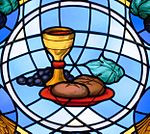This article needs additional citations for verification. (April 2021) |
| Part of a series on the |
| Eucharist |
|---|
 |
Anglican eucharistic theology is diverse in practice, reflecting the comprehensiveness of Anglicanism.[citation needed] Its sources include prayer book rubrics, writings on sacramental theology by Anglican divines, and the regulations and orientations of ecclesiastical provinces. The principal source material is the Book of Common Prayer (abbr: BCP), specifically its eucharistic prayers and Article XXVIII of the Thirty-Nine Articles. Article XXVIII comprises the foundational Anglican doctrinal statement about the Eucharist, although its interpretation varies among churches of the Anglican Communion and in different traditions of churchmanship such as Anglo-Catholicism and Evangelical Anglicanism.
Anglican eucharistic theologies universally affirm the real presence of Christ in the Eucharist, though Evangelical Anglicans believe that this is a pneumatic presence, while those of an Anglo-Catholic churchmanship believe this is a corporeal presence.[1] In the former interpretation, those who receive the form or sign of the body and blood (bread and wine) in faith, receive also the spiritual body and blood of Christ. Those who receive the form or sign without faith, or for those who are wicked, Christ is not present spiritually and they consume only the physical signs of this holy presence, which further adds to their wickedness – in accordance with Article XXIX.[2] In the latter interpretation, there exists the corporeal presence of Christ in the Eucharist, although the precise manner of how that presence is made manifest is a mystery of faith.[3] To explain the manner of Christ's presence, some high-church Anglicans, however, teach the philosophical explanation of consubstantiation,[4] associated with the English Lollards and, later, erroneously with Martin Luther, though Luther and the Lutheran churches explicitly rejected the doctrine of consubstantiation and actually promulgated their dogma of the sacramental union.[5] A major leader in the Anglo-Catholic Oxford Movement, Edward Pusey, championed the view of consubstantiation.[6]
- ^ Campbell 1996, p. 325.
- ^ "The Thirty-Nine Articles". Archived from the original on 1 July 2007. Retrieved 8 April 2015.
- ^ Herbert Stowe 1932; Lears 1981, p. 202.
- ^ Murphy 2007, p. 512.
- ^ Diehl 1888, pp. 349–350; Mattox & Roeber 2012, p. 54.
- ^ Rigg 1895, p. 293.
© MMXXIII Rich X Search. We shall prevail. All rights reserved. Rich X Search
